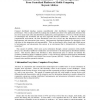Free Online Productivity Tools
i2Speak
i2Symbol
i2OCR
iTex2Img
iWeb2Print
iWeb2Shot
i2Type
iPdf2Split
iPdf2Merge
i2Bopomofo
i2Arabic
i2Style
i2Image
i2PDF
iLatex2Rtf
Sci2ools
ISSADS
2005
Springer
2005
Springer
Database System Architecture - A Walk Through Time: From Centralized Platform to Mobile Computing - Keynote Address
Classical distributed database systems monolithically offer distribution transparency and higher performance. This is made possible by making data available and closer to the application domain(s) that uses it by means such as the data distribution, duplication, and fragmentation. However, with the advances in technologies this monolithic and top down approach becomes insufficient. In the new networked computational environment, the data distribution issue has evolved into data integration from several heterogeneous and autonomous data sources. Heterogeneous distributed databases are designed to deal with issue of data integration and interoperability. They are developed to allow timely and reliable access to heterogeneous and autonomous data sources in an environment that is characterized as “sometime, somewhere.” The concept of mobility, where users access information through a remote connection with portable devices, has introduced additional complexities and restrictions to th...
Database Systems | Distributed And Parallel Computing | Distributed Database | Heterogeneous Distributed Database | ISSADS 2005 |
| Added | 28 Jun 2010 |
| Updated | 28 Jun 2010 |
| Type | Conference |
| Year | 2005 |
| Where | ISSADS |
| Authors | Ali R. Hurson, Yu Jiao |
Comments (0)

